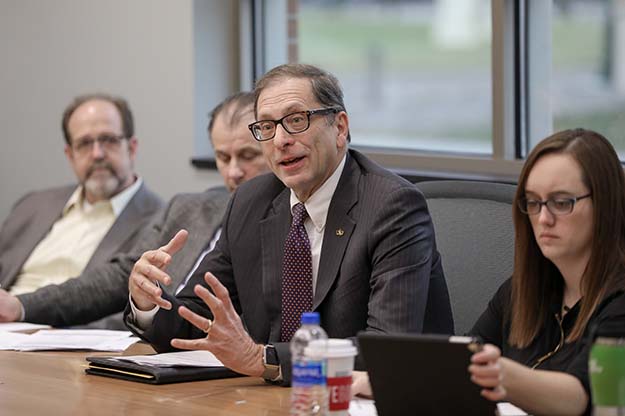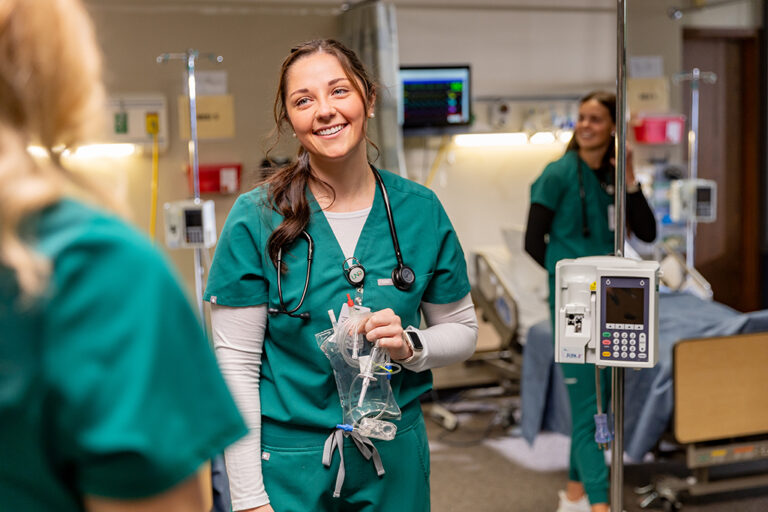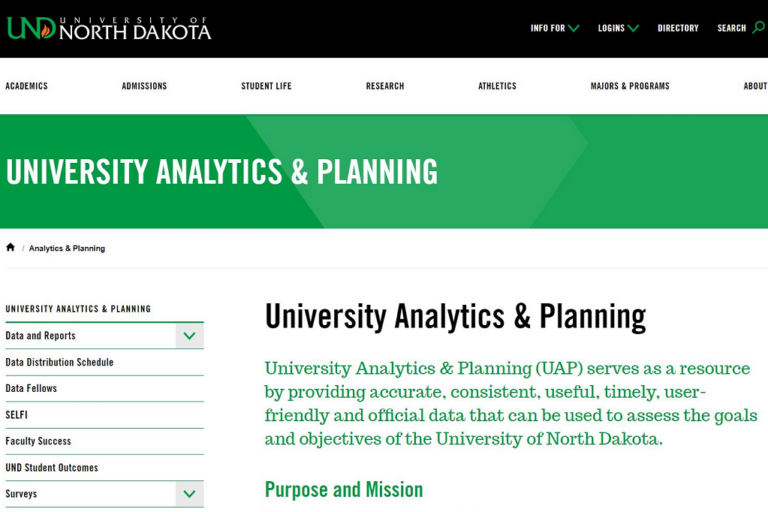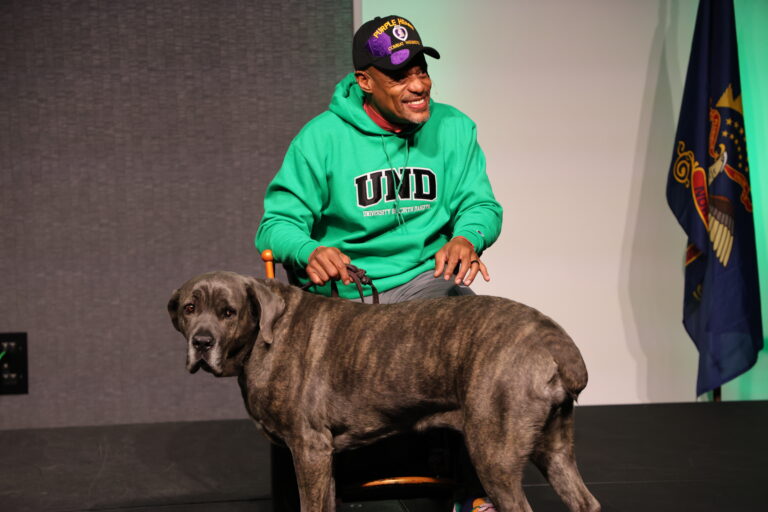North Dakota’s opportunity engine picks up steam
UND Strategic Plan leaders mark victories in enhancing learning, discovery and engagement

On Nov. 27, for the second time in five days, UND President Mark Kennedy gathered around a large table for a time of sharing. But instead of turkey and cranberry sauce, his tablemates were passing around status reports of the One UND Strategic Plan.
“When I sat down for Thanksgiving and thought about what I’m thankful for, I’m thankful for everybody putting in the hard work and diligent effort to keep this plan moving forward,” President Kennedy said to those surrounding him.
The goal captains of the Strategic Plan used the President’s Cabinet meeting to present their implementation teams’ latest accomplishments, lay out the next tasks on their timelines, and ask for input from other cabinet members.
The full Strategic Plan charter, complete with action items and metrics, can be found here.
Goal No. 1 – Provide a strong undergraduate liberal arts foundation
Debbie Storrs, captain of Goal No. 1 and dean of the College of Arts & Sciences, served up the first progress report. She explained that much of her team’s current work lies in enhancing UND’s high-impact practice (HIP) offerings.
“We’re putting a lot of energy there, because the research shows HIPs really improve student learning outcomes associated with the liberal arts,” Storrs said.
Goal No. 1 committee member Anne Kelsch, UND director of faculty & staff development, is developing a cross-college working group to define HIPs, which will help to identify and evaluate HIPs that are already in place (activities like undergraduate research, internships and service learning). The group will recommend how to best track and assess the outcomes of these activities.
The team also met with the Teaching Transformation and Development Academy (TTaDA) to create seminars explaining the importance of HIPs and the liberal arts to faculty, four of which will be offered this spring semester.
“It’s starting a dialogue,” Storrs said. “Faculty are already doing some HIPs, but how can we do them better, and how can we better document what we’re doing?”

Goal No. 2 – Increase graduation and retention rates
Goal No. 2 Captain and Dean of the College of Engineering & Mines, Hesham El-Rewini, said one of his team’s first major victories was hosting two on-site demonstrations of degree planner possibilities on Nov. 7. Two vendors held sessions with students, faculty and a selection group to show how their products could best serve students in mapping out a plan for on-time program completion.
“We are in the final phase of choosing one of them, so that’s an accomplishment,” El-Rewini said, adding that contract execution with a vendor is expected in December.
The implementation team is also celebrating the completion of a more refined list of tasks to help them better leverage the student success software Starfish, student advisors, financial aid and a first-year experience course.
Goal No. 3 – Deliver more educational opportunities online and on campus
As captain of Goal No. 3, President Kennedy said that steady progress is being made in terms of marketing and online learning initiatives.
Signage branded with “Leaders in Action” has been rolled out across campus, with more to come along Columbia Road. The revamped UND website is on track with a finalized responsive design and a request for proposal for a more vigorous search appliance. The new site will launch in several phases beginning in April 2018.
The team members in charge of marketing are aligning their digital advertising strategy to meet specific enrollment goals and are finding ways to more tightly coordinate with admissions.
They have discussed implementing a new Customer Relationship Management (CRM) software system (for interacting and sharing information with prospective students), which would work in conjunction with North Dakota State University. Kennedy said a new CRM would help UND evaluate the productivity of its advertising efforts.
A partnership outline is progressing with the online program management (OPM) company Pearson, with a goal of launching some Pearson-supported online programs by Fall 2018. Those potential programs will be identified in the next few weeks, with more waves to follow.
“We are not going to pay [Pearson] for things already being done internally,” Kennedy said, addressing concerns he’s heard on campus. “The end result might be that it frees up capacity of TTaDA to focus on online programs that aren’t a part of the partnership. We expect this to be a net revenue generator.”
Dean El-Rewini led a collaborative process that identified a list of high-demand programs addressing data science and cyber security that are progressing through the state approval system.
Goal No. 4 – Enhance discovery at a level consistent with most research-intensive universities (Carnegie R1)
Major movements have been made in the Grand Challenge areas of Goal No. 4, thanks in part to Goal Captain Grant McGimpsey’s team and its establishment of four new seed funding programs offered to faculty and research staff.
“While each Grand Challenge Team has their own plan for distributing research seed funds, the end goal for each is the same – to increase our competitiveness for external funding,” McGimpsey explained.
One of these seed funding programs was announced at a well-attended event held in mid-November, led by Grand Challenge champion Thomasine Heitkamp. The event connected researchers with federal funding agencies from around the country to discuss how to best address rural health care and social issues. “Thomasine’s team organized a really exciting event,” McGimpsey said. “Interest from UND faculty was tremendous.”
The Goal No. 4 group is currently tackling another critical action item – streamlining the process with which faculty can track and report their research and scholarship productivity through the Digital Measures platform. Accurate reporting will help UND reach its goal of a Carnegie R1 research rating.
Goal No. 5 – Foster a welcoming, safe and inclusive campus climate
Goal No. 5 Captain and Vice President for Student Affairs & Diversity Cara Halgren was eager to share the results of four recent visits to North Dakota tribal colleges, with two more campus visits yet to be planned.
“We have an incredible opportunity to partner with our tribal college colleagues and to streamline ways for students to earn a baccalaureate degree from UND,” Halgren explained. “Institutional leaders shared ideas with us that can make this process easier for students, including the clarification of articulation agreements and focusing on recruiting students to academic programs that will prepare them to meet the greatest employment needs of their community.”
UND is in conversations with the Community Violence Intervention Center (CVIC) to create a memorandum of understanding that would place a prevention and education campus coordinator on campus in a space designated as CVIC@UND. Beginning as early as January, CVIC@UND would provide education and training to students on topics such as healthy relationships, dating violence and bystander intervention, building on the strong foundation created by the previous staff of the Women’s Center.
The Goal No. 5 team is also building an enhanced program for incentivizing participation in cross-cultural events, which, starting next summer, will include a student orientation presentation of the multicultural opportunities available throughout the year.
Goal No. 6 – Meet educational needs of active-duty military personnel, veterans and their families
UND Provost and Goal No. 6 Captain Tom DiLorenzo reinforced that his team has solidified a list of degree programs deemed high-demand by military personnel both locally and regionally. Now, they’re connecting with Goal No. 3 to make sure that conversations with the OPM Pearson will advance the online development of those programs.
The committee has also teamed up with the Registrar’s Office and Essential Studies to ensure that military individuals who transfer to UND are clear about how their credits transfer, and to confirm that credits are transferring to the fullest potential.
“We’ve also completed our first submission of materials to the AU-ABC (Air University Associate to Baccalaureate Cooperative). The first one we submitted was General Studies,” DiLorenzo said. “We’ve made really nice progress there.”
Goal No. 7 – Attract support for the University by actively engaging alumni and donors
DeAnna Carlson Zink, UND Alumni Association & Foundation (AA&F) CEO and Goal No. 7 captain, said the AA&F is reviewing its organizational structure and job descriptions to find ways to best support the goal’s action items. For example, a revised position will now focus on young alumni activities.
“We want to try and close that gap for alumni between when they leave the institution and 10-20 years out,” Carlson Zink said.
A working group is coordinating an audit of marketing and communication materials specifically targeted to alumni and donors within colleges and units. The purpose is to establish uniformity in how new donors are brought in and ultimately thanked. Carlson Zink said that consistency leads to better donor retention.
The team is also working with UND Marketing on a “virtual marketing toolkit” to house alumni and donor impact materials – print and digital articles, photos, videos and more – that can be used in fundraising efforts.
“You have to have a good story, a good vision that has to be compelling. That’s why these impact stories are so important,” Carlson Zink said.


